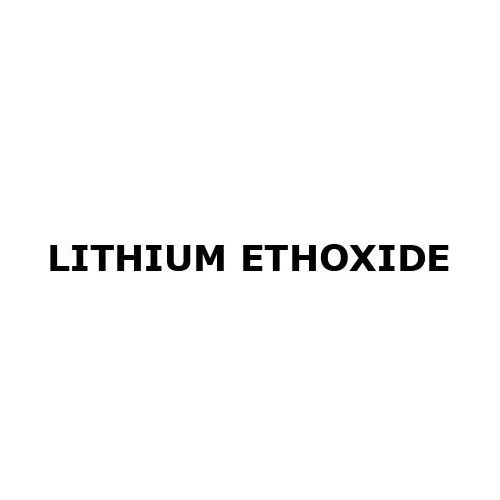Product Description
To fulfill the variegated demands of clients we are engrossed in manufacture and offering of Lithium Ethoxide. The offered chemical compound is used for coatings battery electrolyte port land cement formulations and ceramics. This product is formulated at our modern production unit using pristine quality chemical compounds and advanced processing methodology as per international quality standards. Moreover our clients can purchase it from us in different packaging options as per their needs at marginal prices.
Lithium Ethoxide Properties:
1. PubChem CID: 23661847
2. Molecular Formula: LiC2H5O
3. Molecular Weight: 52.0 g/mol
4. IUPAC Name: lithium;ethanolate
5. CAS Number: 2388-07-0
6. Appearance: White powder and chunks
Lithium Ethoxide Applications:
1. Organic Synthesis: Lithium ethoxide is often used as a base in various organic synthesis reactions, particularly in the formation of carbon-carbon bonds. It can deprotonate acidic compounds, serving as a strong base in reactions such as aldol condensation, Michael addition, and Claisen condensation.
2. Esterification Reactions: Lithium ethoxide can be employed in esterification reactions where it acts as a catalyst or as a reactant. It facilitates the formation of esters by reacting with carboxylic acids or acid chlorides.
3. Formation of Lithium Alkoxides: Lithium ethoxide can react with other alkyl halides or alkoxides to form mixed lithium alkoxides. These mixed alkoxides can be utilized in various synthetic transformations, such as the preparation of organometallic reagents for Grignard reactions.
4. Polymer Chemistry: Lithium ethoxide is also employed in polymer chemistry, particularly in the synthesis of certain types of polymeric materials. It can be used as an initiator or catalyst in the polymerization of certain monomers.
5. Desilylation Reactions: In some cases, lithium ethoxide can be utilized in desilylation reactions where it removes silyl protecting groups from organic compounds. This reaction is important in organic synthesis for accessing specific functional groups.
6. Hydrolysis Reactions: Lithium ethoxide can participate in hydrolysis reactions where it reacts with water to form lithium hydroxide and ethanol. Although this is not a common application, it's worth noting for reactions where water may be present as an impurity.
7. Research and Development: Lithium ethoxide is also utilized in research laboratories for exploring new synthetic methodologies and understanding reaction mechanisms. Its strong basicity and reactivity make it a valuable tool for discovering new chemical transformations.
Lithium Ethoxide FAQ:
Q. What is the appearance of lithium ethoxide?
Ans: Lithium ethoxide typically exists as a white to pale yellow solid. It is often encountered as a powder or granules.
Q. How is lithium ethoxide prepared?
Ans: Lithium ethoxide is typically prepared by reacting metallic lithium with ethanol in anhydrous conditions. The reaction is often carried out under inert gas atmosphere to prevent moisture and air from interfering.
Q. What safety precautions should be taken when handling lithium ethoxide?
Ans: Due to its reactivity and potential hazards, lithium ethoxide should be handled in a well-ventilated area and under inert gas atmosphere. Proper personal protective equipment (PPE) should be worn, including gloves and safety goggles. Care should be taken to avoid exposure to moisture and air, which can cause decomposition and release of flammable gases.
Q. Can lithium ethoxide be stored for a long time?
Ans: Lithium ethoxide should be stored in a dry, air-tight container away from moisture and air. It is best used shortly after preparation to minimize the risk of decomposition and ensure optimal reactivity.
Q. What are some alternatives to lithium ethoxide in organic synthesis?
Ans: Other strong bases such as sodium ethoxide or potassium ethoxide can sometimes be used as alternatives to lithium ethoxide, depending on the specific reaction requirements. Additionally, other organolithium compounds or strong bases like alkoxides of other alkali metals may be employed in certain cases.



